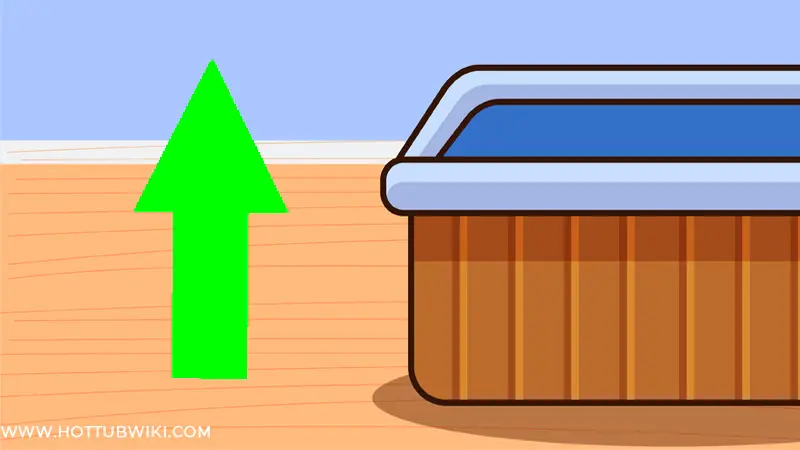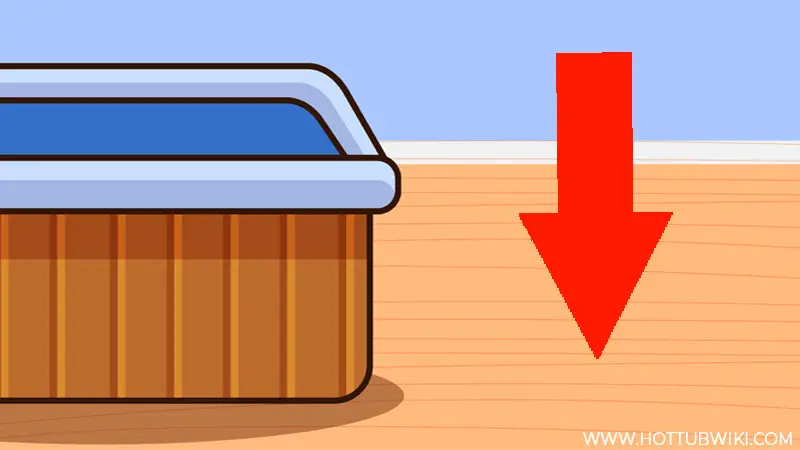Having clean hot tub water relies heavily on the right water hardness level. But the problem is the freshwater that you fill your hot tub with doesn’t always have the right water hardness for your hot tub.
But not to worry, this post reveals a brilliant strategy that can help you to raise or lower water hardness in a hot tub. So let’s dive in.
What Does Calcium Hardness Mean?
Calcium hardness means the amount of dissolved iron in the water. Every source of water has irons in it, usually calcium and magnesium. The amount of these dissolved irons is what is referred to as the calcium hardness of the water.
When the water is hard, that means the amount of dissolved calcium and magnesium in it is high. When the water is soft, it means that the amount of dissolved calcium and magnesium in it is low.
It’s important to have a balanced calcium hardness level in your hot tub water to prevent damages to the hot tub and its components.
The calcium hardness level in your hot tub should be between 150 PPM (parts per million) and 250 ppm with 180 ppm being the sweet spot.
Calcium Hardness vs Water Hardness
There is no difference between calcium hardness and water hardness. Calcium hardness and water hardness are terms that are both used to refer to the amount of dissolved irons in the water. Another term used in this case is total hardness.
Total hardness refers to the amount of dissolved calcium and magnesium in the hot tub water. So in other words, water hardness, calcium hardness, and total hardness all mean the same thing.
If you lower the water hardness of your hot tub water, you are also lowering the calcium hardness and total hardness of the water. It’s the same case if you raise the calcium hardness of the water.
Why is Low Calcium Hardness Bad?
When the calcium hardness level in your hot tub is too low or below 100 ppm, it will damage the hot tub and its components by causing corrosion. Corrosion means that the water in the hot tub will start to eat away at the metal components of the hot tub.
Corrosion will damage the working parts of your hot tub quickly and can be difficult to stop. Corrosion will also cause dents and holes in the working parts of your hot tub causing them to malfunction and break down prematurely.
If the calcium hardness level is low, you will have soft water in the hot tub and soft water is anything but soft. When the water in the hot tub is soft, it means that the water does not have enough calcium in it.
So, the soft water starts to eat away at the metal parts of your hot tub like the heater and jets in search of calcium. A low calcium hardness level in the hot tub water can also cause foaming in the water, staining on the shell of the hot tub, and discoloration.
Low calcium hardness can also damage your concrete base (if you have one).
How to Raise Water Hardness?

If your calcium levels are lower than 100 ppm then you need to raise the calcium hardness immediately to eliminate the risk of corrosion.
The best way to raise the water hardness in your hot tub is to add calcium chloride or calcium hardness increaser to the water. But before you can add calcium chloride to the water, you need a few tools.
- A pair of gloves
- A bottle of calcium chloride or calcium hardness increaser
- A large bucket (optional)
Now, let’s get to work.
Method #1: Use Calcium Chloride
Calcium chloride is a salt compound that has a mix of chlorine and calcium molecules (2:1 ratio). Calcium chloride is used for different things such as ice melting, road surfacing, and balancing water hardness.
Calcium chloride can be used to increase (by adding it to the water) and decrease (by removing it from the water) water hardness. Most of the “calcium increaser” products are just calcium chloride.
Here’s how to add calcium chloride to water:
- Test The Water: Use a test strip or liquid test and check your calcium levels. Write down the levels so you can know where you started from.
- Measure The Amount Of Calcium Chloride: As a rule of thumb, 1 ounce of calcium chloride will raise calcium levels by 5 ppm for every 500 gallons of water you have. If you have a larger or smaller hot tub, then you will have to do some math.
- Mix Calcium Chloride With Water: Add the needed calcium chloride and water in an empty (and clean) bucket. Use a wooden stir to mix these.
- Add the mixture to the water: Before you add the mixture, make sure to have your hot tub jets on. After you add the mixture, use a brush to clean the hot tub shells.
- Wait 4 hours and then re-test the water.
Except for the calcium levels, you will also have to check the pH and alkalinity levels. That’s because calcium chloride affects them both.
Method #2: Use Calcium Hypochlorite
Another way to raise the water hardness is to use calcium hypochlorite. Calcium hypochlorite has a 65-70% concentration of chlorine. It is mainly used as a shock for hot tubs and pools due to its high level of chlorine. Except for chlorine, it also contains calcium (hence the name).
If you add calcium hypochlorite to the spa, you will raise free chlorine and calcium levels at the same time. For every ppm of free chlorine, the calcium levels will be raised by 0.8 ppm.
So, if you raise free chlorine levels by 10 ppm, the calcium levels will raise 8 ppm. This means that the levels can get out of control very easily, and that’s why it’s not recommended as a first choice to raise calcium levels in a hot tub.
Method #3: Use Baking Soda
Another way to raise water hardness is by using baking soda. While baking soda does a good job, it’s just a temporary solution. Baking soda will also raise pH and alkalinity levels in your hot tub.
When raising the water hardness, make sure to stick to one method. Using two different methods at the same time will cause different reactions. If you use calcium chloride and baking soda at the same time, it will cause cloudy spa water.
Why High Calcium is Bad?
When the calcium hardness in your hot tub is too high or above 400 PPM, it will damage your hot tub and its components by causing hot tub scale. Hot tub scale is a whitish coat that appears on different parts of your hot tub. The scale is often flaky and can be very difficult to remove.
The hot tub scale usually attacks the metal components of the hot tub like the heater, the jets, and the shell of the hot tub. The hot tub scale will cover the surface of the heater making it difficult for water to reach the heater. This can damage the heater by causing burnout of the heating mechanism. The scale can also affect the circulation pump by accumulating in the pump’s impeller.
A high calcium hardness level can also cause cloudy spa water, low water flow, and unbalanced water chemistry. Eventually, you will find yourself spending hundreds of dollars on repairs and replacement of your hot tub’s components if there is too much calcium hardness in the water.
How to Lower Water Hardness?
If the test results showed that the calcium hardness level of your hot tub is above 250 PPM, then you need to lower it immediately to prevent hot tub scale.
Method #1: Drain and Re-Fill The Hot Tub
The best way to lower water hardness is to drain the water. But there are a few steps to follow before you do that. Let’s get to work.
- Turn Off the Hot Tub: It’s never a good idea to drain your hot tub when it’s still running. You can also turn off the GFCI breaker to cut off all power supply to the hot tub temporarily.
- Determine how much water you need to drain from the hot tub: If the calcium hardness level is a bit above the recommended range (250 ppm), then you need to drain a few gallons of water. If the calcium hardness level is way above the recommended range or over 400 ppm, then you need to empty and clean the hot tub.
- Drain The Hot Tub: To drain the hot tub, you need to locate the drain valve (base of the hot tub). Connect a hose and let the water escape.
- Add a Scale Control to the Water: If you drained part of the water, you should top up the remaining water by adding fresh water to the hot tub. Then add a scale control product to the water to prevent the calcium levels from rising again. If you drained the entire hot tub because of a very high calcium hardness reading, then you don’t need to add any scale control product, at least not yet.
- Clean & Re-Fill The Hot Tub: If you emptied the hot tub, ensure to clean it and refill the hot tub with fresh water. Then test the water for water hardness. If it’s low, you should incense it by adding a calcium hardness increaser. After that, you can add a scale control product to the water.
Method 2: Use Water Clarifier or Flocculant
Draining and re-filling takes a lot of time. If you don’t want to do that, then you can use a water clarifier or flocculant to lower calcium levels in a hot tub.
The way these two work is that they coagulate the calcium deposits in a hot tub and then sink it at the bottom. All you have to do is scoop them with a net. You can also use it to get rid of cloudy spa water or make the water crystal clear.
If we compare flocculant and water clarifier, then flocculant is faster. But, the water clarifier makes it easier for you to scoop the calcium deposits.
Here’s how to add it to the water:
- Turn on Jets: The flocculant has to circulate through the water, and hot tub jets will help with that.
- Add the needed amount: Check the bottle of water clarifier or flocculant to know exactly how much you need.
- Pour the needed amount: Wait a few hours before you check the hot tub.
- Use a Skimmer: After a few hours, the products will do their job, and now you need to use a skimmer to pick up the calcium deposits.
- Clean the Filters: Since you add hot tub jets on, the flocculant (or water clarifier) has circulated around the hot tub, including filters. You might have some calcium deposits in the filters, so it’s best to clean them.
Final Words
Overall, having a high or low calcium hardness level in your hot tub is not unusual since many water sources don’t have the right calcium hardness level needed for your hot tub.
But you need to stay ahead of the situation by testing the water regularly for calcium hardness level. If you notice the water hardness is below or above the recommended range, you should fix it immediately to prevent damages.

